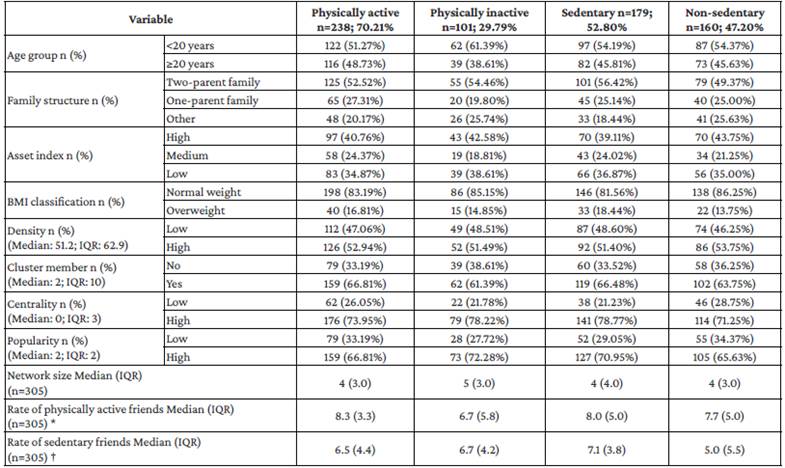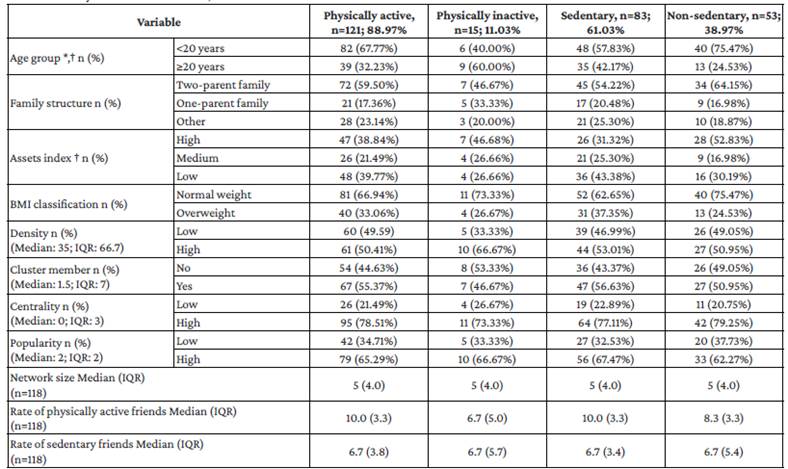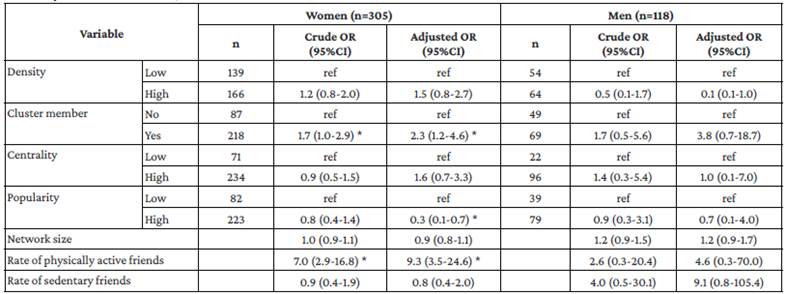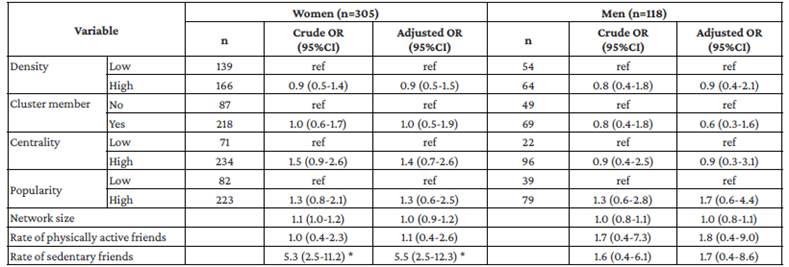Introduction
Among university students, physical activity and sitting times are crucial health-related behaviors associated with the development of health conditions in their future lives. Compared with the multiple advances on physical activity, research interest regarding sedentary behavior is more recent; it is critical to remember that this behavior is different from physical inactivity (physical activity level below the physical activity recommendation), 1 since meeting the physical activity level recommendation (i.e., being physically active) may simultaneously occur with high sedentary behavior levels. A sedentary behavior is defined as any waking behavior characterized by low energy expenditure (≤1.5 metabolic equivalents) and performed while in a sitting, laying, or reclining posture.1 This behavior may be observed in several scenarios such as school, work, leisure time (including recreational screen time), and transportation.1
Transitioning to postsecondary education results in a decline in physical activity levels and an increase in sedentary behavior. 2 In this sense, it is expected that university students show high levels of occupational sedentary behavior during classes or while studying. 3 Furthermore, university students also have higher levels of recreational screen time, thus accumulating sedentary time that increases their risk of adverse health outcomes. 4,5
International estimations point out that the proportion of university students who meet the physical activity recommendations ranges between 19.4% and 78.2%;6 in Colombia, this proportion was estimated at 68.9%.6 In a systematic review analyzing 23 articles exploring excessive sedentary behavior among university students, prevalence rates ranged between 34% and 90%, with a diversity of cutoff points and sedentary behavior domains. 7
The transition to adulthood is a critical period for adaptive functioning. 8 During this period of transition, obtaining a university degree is one of the options for a better career in the future. Upon entering a university, students adopt new roles, form new friendships, distance themselves from their family and old friends, face more academic demands and increase their independence, while parental support, guidance, and monitoring are reduced. 9 These conditions characterize the university environment and may influence the adoption of behaviors that affect students' health, so the university provides an appropriate setting for the development of health-related behaviors. In particular, the formation of new friendships leads to the expansion of friendship networks, which may have an impact on the health of the individual; in this regard, the study of the relationship between friendship networks and health has revealed how social interaction may influence behavior. 10
Friendship network refers to a collective of actors that interact with each other to create a social structure, and social network analysis is the strategy and set of tools used to explore the connections between them. 11 This network offers relevant resources for the adoption and maintenance of certain health-related behaviors, such as physical activity and sedentary behavior. 12 For instance, a previous social network analysis revealed that close friends share their physical activity habits. 13 Additionally, social dynamics relating to physical activity and sedentary behaviors can be differentiated by sex, 14 and the physical activity level of friends has a significant effect on physical activity levels of the individual. 14,15
Despite the important findings about friendship networks and physical activity and sedentary behavior, it has been suggested that the study of the associations between friendship and behaviors is emerging16 and this subject requires additional research. 14 Understanding the social dynamics driving behavior is essential for public health initiatives in the field of physical activity promotion and sedentary behavior reduction. 16 In consequence, the aim of the study was to explore the associations of the characteristics of the social network of friends with being physically active and sedentary behavior in university students. It was hypothesized that some network characteristics were associated with being physically active and having a sedentary behavior.
Materials and methods
Design and sample
This is a cross-sectional study, based on a social network analysis, conducted in a private university located in Medellín, Colombia, in 2018. Students enrolled in the five largest undergraduate programs offered by the university and between the second and sixth semesters were invited to participate in the study (sample frame of approximately 3 000 students). These semesters were selected because, by the second semester, students have had enough time to establish friendships in the university, and by the sixth semester, most of the students' academic activities, such as practicums and/or internships, are performed off-campus, limiting social interaction among them.
Participants were recruited while attending their classes/courses, and only those who were apparently healthy and voluntarily decided to take part in the study were included. Students with motor or sensory disorders that make impossible the practice of physical activity were excluded. Questionnaires were administered to the students who signed the informed consent form.
Considering the cross-sectional design of the study and having 0.5 as the proportion of a binary outcome, the minimum sample size was estimated at 390 participants. The final convenience sample was comprised of 475 university students (mean age: 19.8, SD: 2.4; women 72.1%), from five undergraduate programs (Medicine, n=53; Physical therapy, n=241; Nutrition and Dietetics, n=92; Biology, n=46; Pharmaceutical Chemistry, n=43), who were distributed in eighteen classes/courses and formed eighteen friendship networks.
The study protocol followed, at all times, the universal code of ethics, the ethical principles for conducting medical research involving human subjects outlined by the Declaration of Helsinki, 17 and the administrative, technical and scientific standards for conducting health research established in Resolution 8430 of the Colombian Ministry of Health. 18 In addition, the study protocol was reviewed and approved by the Research Ethics Committee of the Instituto de Educación Física of the Universidad de Antioquia (as stated in Minutes N° 026-2017, March 28, 2017).
Instruments and measurements
Outcome variables
Physical activity was measured using the Global Physical Activity Questionnaire (GPAQ), 19 which covers three physical activity domains: occupational, transportation-related, and leisure-time physical activity; the instrument has documented reliability and validity. 20 Participants were asked to self-report the GPAQ; although it was designed to be interviewer-administered, the self-reported version of the GPAQ has shown to be as reliable as the interviewer-administered version. 21 Responses were analyzed taking into account the global physical activity recommendations. 22 Consequently, participants who reported to engage in at least 150 minutes per week of moderate-intensity physical activity, or at least 75 minutes per week of vigorous-intensity physical activity, or an equivalent combination of both intensities, were classified as physically active. The remaining responders were classified as physically inactive.
On the other hand, sedentary behavior was assessed using the Adolescent Sedentary Activity Questionnaire (ASAQ), 23 which is useful to measure sedentary behavior in students. In this instrument, different sedentary activities are explored, including screen time, education, social activities, transportation, and cultural activities. For the present study, only the recreational screen time domain was analyzed, considering that it is the most salient sedentary behavior domain among university students. 5 Responses were dichotomized in light of the suggestion to limit screen usage to no more than 2 hours per day. 24 Participants who reported 3 or more hours per day of screen time were categorized as sedentary, whereas the remainder were categorized as non-sedentary.
Independent variables
Friendship network variables were considered as independent variables. Students were asked to indicate the name of their closest friends from the same undergraduate program, with a maximum of 10 close friends being reported. The category best friend was operationalized in the instrument as "individuals with whom you have a close friendship, meet frequently, often play and do the same activity, and share an interest in some activity." Following that, friend nominations were analyzed using the egocentric network analysis approach; in this type of network analysis, individual and personal network characteristics are employed as units of analysis. 25 Using the software UCINET, a package for the analysis of social network data, 26 and based on the nominations made and received, seven network variables were extracted for each participant:
Density (ego network density): number of nominations among the nominated friends.
Cluster member (nClosed): number of times the participant is connected with two other participants and the three form a closed triad.
Centrality (EgoBetweenness): number of times the participant is on the shortest path between two participants.
Popularity: total number of nominations received.
Network size: number of nominations made.
Rate of physically active friends: proportion of nominations made to and received from individuals who are categorized as physically active.
Rate of sedentary friends: proportion of nominations made to and received from individuals categorized as sedentary.
The variables density, centrality, and popularity were dichotomized (low and high) using median threshold values in each of the eighteen analyzed networks. The term cluster member refers to whether or not a participant is a member of at least one closed triad. The network size variable was not transformed. The variables rate of physically active friends and rate of sedentary friends were calculated as percentages and rounded to tens.
Covariates
Participants reported sociodemographic information including sex, age (less than 20 years old, 20 years old or more), and family structure (two-, one-parent family, and other). Asset index applied in previous studies conducted in Latin America27,28 was used as a proxy of socioeconomic status, which was grouped into tertiles (high, medium, and low). Body mass index (BMI) was also assessed and dichotomized as normal weight (BMI<25) and overweight (BMI≥25).
Questionnaires on physical activity, sedentary behavior, and socioeconomic status were pilot-tested in a sample of 60 university students using test-retest reliability (one-week interval), resulting in good and excellent intraclass correlation coefficients (ICC) of 0.86 (95%CI: 0.77-0.92) for GPAQ, 0.75 (95%CI: 0.56-0.85) for ASAQ, and 0.96 (95%CI: 0.940.98) for asset index.
Data analysis
Descriptive statistics were analyzed and stratified by sex performing a Chi-square test for categorical variables, and a Mann-Whitney U-test for continuous variables, i.e., rate of physically active (Shapiro-Wilk test: W=0.82, 423, p<0.001) and sedentary friends (W=0.92, 423,p<0.001).
Sex-stratified logistic regression models were performed to test the binary (crude odds ratio, OR [cOR]) and multivariate (adjusted OR [aOR]) associations between the characteristics of the friendship network and being physically activity and having a sedentary behavior. Confidence intervals (95%) were estimated, and statistical significance was defined with p-values <0.05.
The estimated OR for the variables rate of physically active friends and rate of sedentary friends were interpreted as a unit of change indicating a ten-percentage points change in both variables. Participants without friend nominations, made or received, were excluded from the regression models. All analyzes were performed using the SPSS statistical software package version 24 (SPSS Inc., Chicago, IL).
Results
Descriptive statistics are shown in Tables 1 and 2, for women and men, respectively.
Table 1 Description of sociodemographic characteristics, friendship network characteristics, physical activity, and sedentary behavior in 339 female university students in Medellin, 2018.

BMI: Body mass index; IQR: Interquartile range.
* Statistically significant differences between physically active and inactive female university students (Mann-Whitney U-test).
† Statistically significant differences between sedentary and non-sedentary female university students (Mann-Whitney U-test).
Source: Own elaboration based on data obtained in the study.
Table 2 Description of sociodemographic characteristics, friendship network characteristics, physical activity, and sedentary behavior in 136 male university students in Medellin, 2018.

BMI: Body mass index; IQR: Interquartile range.
* Statistically significant differences between physically active and inactive male participants (Chi-squared test).
† Statistically significant differences between sedentary and non-sedentary participants (Chi-squared test).
Source: Own elaboration based on data obtained in the study.
The median age of women was 19 years (IQR=3), and 70.29% and 52.80% reported being physically active and sedentary, respectively. In men, the median age was 19 years (IQR=2), and 89.97% and 61.03% were physically active and sedentary, respectively.
Friendship network variables were calculated only with those participants who made or received at least one friend nomination (n=423). Information was obtained from 64.40% of all the nominated students. There were no differences in being physically active and having a sedentary behavior after comparing students who made or received at least one friend nomination with those who did not.
Active women, compared with physically inactive women, had a significantly higher rate of physically active friends (17=7086, p=0.001). Similarly, the rate of sedentary friends was significantly higher among sedentary women compared to non-sedentary women (7=8583, p=0.001). No statistical differences were found for the remaining variables analyzed.
In the case of men, the proportion of age group was significantly different between physically active and inactive students (x 2 [1, n=136) =4.5, p=0.034) and between sedentary and non-sedentary individuals (x2 [1, n=136] =4.4, p=0.036). The proportion of the asset index variable was significantly different between sedentary and non-sedentary men (2, n=136) =6.2,p=0.044]. There were no statistically significant differences in the remaining variables analyzed.
Table 3 presents the results of the analysis of the association between the friendship network variables analyzed and being physically active. Adjusted regression models for women showed that being part of at least a cluster of friends was significantly associated with being physically active (aOR: 2.3; 95%CI: 1.2-4.6) and that being popular was significantly associated with a lower likelihood of being physically active (aOR: 0.3; 95%CI: 0.1-0.7). Moreover, a ten-percentage point increase in the number of active friends was significantly associated with a higher probability of being physically active (aOR: 9.3; 95%CI: 3.5-24.6). In men, none of the associations studied were statistically significant.
Table 3 Logistic regression analysis for the associations between friendship network characteristics and physical activity level in 423 university students in Medellin, 2018.

* Statistically significant associations. Models adjusted by age group, family structure, asset index, BMI classification, and the seven friendship network variables.
Source: Own elaboration based on data obtained in the study.
The analysis of the associations between the variables studied and having a sedentary behavior are shown in Table 4. According to the adjusted regression models, a ten-percentage point increase in the number of sedentary friends in women was significantly associated with a higher probability of being sedentary (OR: 5.5; 95%CI: 2.5-12.3). In men, none of the associations studied were statistically significant.
Table 4 Logistic regression analysis for the associations between friendship network characteristics and sedentary behavior in 423 university students in Medellin, 2018.

* Statistically significant associations. Models adjusted by age group, family structure, asset index, BMI classification, and the seven friendship network variables.
Source: Own elaboration based on data obtained in the study.
Discussion
The objective of the study was to explore the associations of the characteristics of the social network of friends with physical activity and sedentary behavior in a sample of university students.
The proportion of participants who meet the recommended levels of physical activity (70.29% female and 89.97% male students) is higher than the prevalence reported in several countries, as evidenced by Pengpid et al.6 in a study conducted in 17 928 undergraduate students from 23 low, middle and high-income countries, and in which the overall prevalence of physical inactivity was 41.6%, ranging from 21.9% to 80.6%.
On the other hand, the frequency of excessive sedentary behavior (52.80% for women and 61.03% for men) is in the line with what has been described by several reports, as shown by Franco et al.7 in a systematic review that included 23 studies in which prevalence of sedentary behavior for sitting time was found to be 34% for the ≥10 h / day cutoff point, 48.4% for the ≥5 h / day cutoff point, and 82.5% for ≥3 h / day cutoff point.
The results obtained here show that some characteristics of the friendship networks were associated with the level of physical activity and sedentary behavior, as it was initially hypothesized. In this regard, in the case of female participants, being a member of at least one cluster of friends was significantly associated with being physically active (aOR:2.3), and a ten-percentage point increase in active friends was significantly associated with a higher probability of being physically active (aOR: 9.3), while, on the contrary, being popular was associated with a lower probability (aOR: 0.3).
Being part of a cluster of friends is a typical social dynamic for university students. The impact of having peers on academic achievement in university students has been widely studied; 29,30 however, the associations between clusters of friends and physical activity levels are studied more frequently in adolescents, and results are not consistent. For instance, whereas researchers, such as Sawka et al31 in a study conducted in 1 061 adolescents (11-15 years old) from Canada, have found no association between belonging to triads of friendship and being physically active, while other studies, such as the one conducted by de la Haye et al.13 in adolescents (predominantly aged 13-14 years) from two schools in a major Australian city and in which 3 friendship networks strongly segregated by sex were established, have reported that being part of triads of friendships is associated with being physically active. 13
The findings of the present study, which in the case of female participants showed a positive association between being a member of at least one cluster of friends and being physically active, may be explained by the 70.29% prevalence of physical activity in women, i.e., two out of every three women were physically active. In consequence, there was a high probability of finding physically active women within triads of friends. This finding may also indicate the effects of strong relationships within small groups of friends on personal behavior.
In social network analysis, popularity reflects how an actor with a specific trait is nominated. 32 Popularity manifests as a positive appreciation from peers and is a positive marker of social adaptation. 33 The negative association between popularity and physical activity found in the female participants of the present study is inconsistent with studies conducted in school settings, in which the associations between popularity and physical activity were positive13 or not significant. 31 This discrepancy reflects that behaviors associated with popularity and valued by the peer system may differ between university and school settings. 34 Perhaps, the time engaged in physical activities could be limiting the time used for other forms of social interaction that are more valued by the social environment of the university student, resulting in fewer opportunities to engage in behaviors different from physical activity and socially appreciated by university peers.
According to the results of the present study, the more active friends a female university student has, the more likely she to be physically active, whereas the more sedentary friends she has, the more likely she to be sedentary; these findings are confirmed by previous studies. 16,31,35 In addition, studies such as the one conducted by Salvy et al.36 in 44 boys and 44 girls between 12 and 14 years of age in United States, have described that the presence of a friend increased the participant's motivation to be physically active (p<0.001). In this regard, it has been pointed out that peers may influence an individual's healthy behavior by acting as motivational agents, modeling and engaging in healthy behavior, providing social support, creating conditions for vicarious learning, and increasing opportunities for physical activity. 37
In men, none of the studied associations between personal network traits and being physically active or sedentary were significant. It seems that physical activity levels and sedentary behavior in male university students are not affected by the dynamics of their social network of friends, although other studies have described these associations. 16,31 Further studies are needed to clarify the associations between social dynamics and physical activity and sedentary behavior in male university students.
The findings of the present study have implications for physical activity promotion and sedentary behavior reduction efforts. The presence of a cluster of friends is a beneficial friendship network trait for the spread of healthy behaviors within the clusters. 38 Therefore, the negative relationship between popularity and physical activity levels found in the present study raises questions about the processes underlying this association, which requires further research.
Furthermore, the proportion of both active and sedentary friends is a clear indicator of personal network exposure, which is a trait of the friendship network structure39 that, in this case, affects an individual's behavior. This finding suggests that personal network exposure is useful to design network interventions based on peer interactions. A potentially effective strategy could focus on making active friend groups more attractive to university students and fostering social connections within these groups. 37
This study has some limitations. First, the research design did not allow to infer causal relationships. Even though friendship network variables were taken as correlates of physical activity and sedentary behavior, it is likely that the behavior of network members has an impact on the network structure. 39 Second, the friendship networks studied were framed in relationships with classmates; friendships outside the university were not explored. Third, other friendship network configurations, such as homophily, network tie strength, frequency of interaction, among others, and other sedentary behavior domains, were not included in the analysis. Fourth, the use of self-reported measures may include social desirability bias. Finally, the generalization of the findings of the study is limited to considering the use of a convenience sample.
On the other hand, the strengths of the study include that, to the best of our knowledge, this is one of the few studies exploring the associations of friendship network characteristics with physical activity levels and sedentary behavior in university students. In addition, the inclusion of sociodemographic variables, along with several network characteristics in the regression models, allowed obtaining robust results about the associations studied.
Conclusion
Some features of friendship networks are relevant for female university students in relation to their physical activity levels and sedentary behaviors, since being a member of at least a cluster of friends and having a higher rate of active friends were positively associated with meeting the recommended physical activity levels. In turn, the rate of sedentary friends was positively associated with sedentary behavior. These findings highlight the need to consider friendship network dynamics in the design of initiatives aimed at physical activity promotion and sedentary behavior reduction. However, all these associations are largely limited to only university female students; therefore, further research is necessary to explore the impact of peers on healthy behaviors among male university students.















